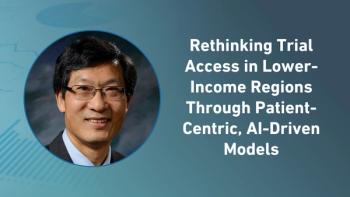
- Applied Clinical Trials-06-01-2023
- Volume 32
- Issue 6
eConsent is Not What You Think
Harmonization and value insights are fundamental to bring eConsent to the place it deserves.
Remote consenting, electronic signatures, I like it, I hate it. Numerous interpretations, various feelings about eConsent. We lost control of what eConsent is about. This article will delve into the fundamental aspects of eConsent to bring it again on track and to the place it deserves.
Whether remote consenting, electronic signatures, or any other electronic consent (eConsent) description, the commonality in all eConsent interpretations is the use of one or more digital features to support the consenting process between participant and investigator. A process that has not changed—all consent process steps are still applicable—but where each consent process step might or not, include one or more digital features as outlined in Figure 1 below.
There is no one size fits all eConsent model. Each disease, each study, each site, each participant might have different needs.
For example, “remote consenting” can be an option but eConsent can also be done entirely in person (at the site, at home). Even without the need of any digitally experienced or digitally equipped participants but by using the site’s electronic device and providing a signed paper copy at the end. Similarly, “electronic signatures” can be an option but signing can also be done on paper (~ wet ink signature) with signed paper upload and/or consent confirmation in the eConsent tool.
Common misunderstandings on (e)Consent
“The shorter, the better.” It is not about shrinking the study information into a short and nice-looking summary or video. Participants have the right and must be informed about all the relevant aspects of the clinical trial that they are signing up for.1 Moreover, with the rising use of digital technologies (e.g. wearables, apps) and increasing participants’ responsibilities, the need for extra information is only increasing. Hence, the “length” of the information sharing, should never be the focus.
“Responsibilities have changed”. Adding digital features does not change the responsibilities for the investigator, who still owns the consent process. But similar as with former paper-to-digital transformations (e.g. pCRF to eCRF, PRO to ePRO), eConsent tool validations, certifications, trainings, etc need to be ensured and provided by the sponsor.
“No document anymore”. The consent document is not only the input but also the output and final agreement between participant and investigator. The ability to store and retrieve the document (e.g. by printing, downloading) is a “must have” digital feature of each eConsent tool.2,3
Flexibility and value drivers
The choice of eConsent digital feature(s) to use for a specific study requires a careful evaluation of the disease, study, sites, and participants upfront. In some cases, the value driver might be limited to the upfront sharing of the consent form using digital communication features, while in other cases it can be an array of digital features such as a glossary, mark unfamiliar flags and a quiz. Incorporation of more eConsent digital features does not necessarily result in more benefits, it all depends on the value drivers for the participant and investigator.
Clearly the COVID-19 pandemic increased the awareness and openness for eConsent, but it also showed that the impact of in-person contacts should not be underestimated.4 The EMA even recommends a face-to-face consent discussion, unless a good justification “why not” was provided and agreed upon.2
Equally important, eConsent tools should be simple, self-explanatory, and easy-to-use. If they multiply investigator’s workload or frustrate participants, it will not work. Remember, “bad technology is worse than no technology.”
Besides the value for participants and investigators, eConsent tools might also be beneficial for all stakeholders involved, as illustrated in Figure 2. For example, having insights with one mouse click into accessibility (e.g. who has accessed the participant consent data, and when and why?), optional agreements (e.g. which participant agreed with biosamples, secondary use of data) or the overall consent process (e.g. was the participant able to ask questions, and were they answered?).
Reduced missing or incorrect consent data entries, no wrong versions provided, and less compliance challenges with downstream processes are some other potential values that eConsent might bring. And eConsent can also be the first step to enable broad inclusiveness and diversity by offering any physician, any community worker, etc a tool to introduce what it is all about in line with the capabilities and needs of that specific participant or population group.5
All the above aspects should be considered when selecting the eConsent digital features for a disease, study, sites and participants. There is no one size fits all eConsent model. Ultimately, eConsent tools should be flexible and become as easy to use and create as a paper consent.
Bringing eConsent on track through harmonization
As the leader of J&J’s first global eConsent study back in 2013,6 and Transcelerate eConsent project with end deliverables released in 2018,7 it’s hard to gauge where we stand today with eConsent. We need to get back to the basics of what eConsent is about, harmonize terminologies and processes, gain insight in the needs and challenges of key stakeholders and reduce the numerous conflicting messages of acceptance and non-acceptance at a local level.
Hence, I’m extremely proud to lead the non-profit multistakeholder European Forum Good Clinical Practice (EFGCP) eConsent initiative, where we are exactly targeting these hurdles in the industry. The EFGCP eConsent initiative is divided into different workstreams, each with a specific focus area, that will constitute a practical guideline and database (see Figure 3).
A phased stakeholders’ involvement approach was taken, where in the first phase various top leaders from over 50 pharma, vendors, and academic institutes will draft the first deliverables. Next, input of participants, sites, Ethics Committees and Health Authorities will be collected using material tailored to their interests and needs.
Below are some highlights of where the different workstreams stand since they kicked off late end 2022.
- The Library workstream has finalized an eConsent Digital Feature Glossary, including definitions and examples. In some cases, we need to go to the example level to ensure common understanding. For example, in Europe, following eIDAS regulations,2,3,8 a handwritten signature on an electronic device is an eSignature, while in US, following FDA regulations,9 it is NOT considered an eSignature.
- The Study Docs workstream has launched eConsent Study Docs surveys to get insight into what Health Authorities and Ethics Committees should be informed about (or not), and in which study documents it should be described.
- The Database workstream is developing surveys to get a better understanding of the acceptance/non-acceptance of specific eConsent aspects at the local level. For example, is a handwritten signature on an electronic device allowed, if all identity/authentication methods are identical as with the traditional paper consent process, or which additional measures need to be in place? While the eIDAS Qualified Electronic Signatures is widely accepted in Europe, it might also place a disproportionate burden on both the investigator and the participant and will not always be appropriate, as indicated by some regulatory guidelines.10
- The Stakeholders Value workstreams will dive into the needs and challenges of eConsent from each stakeholder group’s perspective. So, moving away from assumptions but bringing in directly the stakeholders' voices, an approach which has already countered common-held beliefs on e.g. physicians’ low referral rates.11 Guidance on measuring, analysis and reporting of value generated by eConsent models with concrete data will also be a focus item, as to date, there are limited publications available that address this.
We are just at the start of this exciting journey to bring eConsent again on track. But with all the enthusiasm and engagements ongoing in the EFGCP eConsent initiative, I trust that as a multistakeholder community, we will achieve our goals and bring eConsent finally to the place it deserves.
References
- EMA, ICH E6 (R2) Good Clinical Practice - Scientific Guideline (June 2017).
https://www.ema.europa.eu/en/ich-e6-r2-good-clinical-practice-scientific-guideline - European Commission, Recommendation Paper on Decentralized Elements in Clinical Trials (December 2022).
https://health.ec.europa.eu/latest-updates/recommendation-paper-decentralised-elements-clinical-trials-2022-12-14_en - EMA, Guideline on Computerized Systems and Electronic Data in Clinical Trials (March 2023).
https://www.ema.europa.eu/en/documents/regulatory-procedural-guideline/guideline-computerised-systems-electronic-data-clinical-trials_en.pdf - van Rijssel, T.I.; de Jong, A.J.; Santa-Ana-Tellez, Y.; et al. Ethics Review of Decentralized Clinical Trials (DCTs): Results of a Mock Ethics Review. Drug Discov. Today. 2022, 27 (10), 103326.
https://www.sciencedirect.com/science/article/pii/S1359644622002963 - eConsent: The First Step to Enable Clinical Trial Access to Anyone, anytime, anyplace. Applied Clinical Trials. May 2, 2022,
https://www.appliedclinicaltrialsonline.com/view/econsent-the-first-step-to-enable-clinical-trial-access-to-anyone-anytime-anyplace - eConsent Study Provides Insights to Shape Industry Adoption. Applied Clinical Trials. August 1, 2016,
https://www.appliedclinicaltrialsonline.com/view/econsent-study-provides-insights-shape-industry-adoption - Vanaken, H.; Masand, S.N. Awareness and Collaboration Across Stakeholder Groups Important for eConsent Achieving Value-Driven Adoption. TIRS. 2019, 53 (6), 724-735.
https://journals.sagepub.com/doi/full/10.1177/2168479019861924 - European Union, Regulation (EU) No 910/2014 of the European Parliament and of the Council of 23 July 2014 on electronic identification and trust services for electronic transactions in the internal market and repealing Directive 1999/93/EC (July 23, 2014).
https://eur-lex.europa.eu/eli/reg/2014/910/oj - FDA, Electronic Records, and Electronic Signatures in Clinical Investigations: Questions and Answers (March 2023).
https://www.fda.gov/regulatory-information/search-fda-guidance-documents/electronic-systems-electronic-records-and-electronic-signatures-clinical-investigations-questions - HRA and MHRA Publish Joint Statement on Seeking and Documenting Consent Using Electronic Methods (eConsent). Health Research Authority. September 2018,
https://www.hra.nhs.uk/about-us/news-updates/hra-and-mhra-publish-joint-statement-seeking-and-documenting-consent-using-electronic-methods-econsent/#:~:text=The%20statement%2C%20which%20is%20supported,consent%20for%20participation%20in%20research. - Getz, K. Rebooting the Statistic that 5% of Eligible Patients Participate in Clinical Trials. Applied Clinical Trials. March 2, 2023,
https://www.appliedclinicaltrialsonline.com/view/rebooting-the-statistic-that-5-of-eligible-patients-participate-in-clinical-trials
Articles in this issue
over 2 years ago
Perspective and Hope From the ‘Other Side’over 2 years ago
Changing Behavior: Knowing Doesn’t Equal Doingover 2 years ago
Obtaining Informed Consent for Future Reuse of Patient Dataover 2 years ago
Optimizing the Process for Adopting DCT Solutionsover 2 years ago
Patient Data Return: Do the Benefits Outweigh the Barriers?over 2 years ago
Patient Experience Data: Get Your Copy at DIAover 2 years ago
From 'Brave Spaces' to Battling Bias in Patient Engagementover 2 years ago
Industry Trends: Cycle Time to Resolve Risk Signalsover 2 years ago
A Business Case to Bridge Trials and CareNewsletter
Stay current in clinical research with Applied Clinical Trials, providing expert insights, regulatory updates, and practical strategies for successful clinical trial design and execution.






.png)



.png)



.png)
.png)
